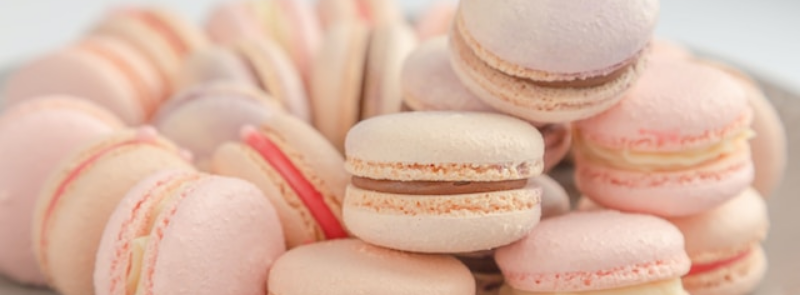
When It Occurs
Every May 31st
Timeline
Days Passed (897)
# Hashtags
#NationalMacaroonDay #CookACookie
Join in the festivities of National Macaroon Day on May 31st by indulging in delectable treats! Originating in the 18th century and initially crafted from shredded coconut, macaroons have evolved into a diverse array of flavors and textures, ranging from chewy to crunchy. This makes them a delightful treat suitable for any celebration. Whether you decide to whip up your own batch or opt for store-bought varieties, seize the opportunity to unleash your creativity and relish the flavors on this special day!
What is a Macaroon?
A macaroon is a type of small cake or cookie, typically made with shredded coconut, egg whites, and sugar. Some variations also use almond paste or ground almonds instead of coconut. Macaroons are often dense and chewy, and they can be either baked until lightly golden or kept softer. They are commonly dipped in chocolate or served plain, and their sweetness pairs well with coffee, tea, or as a standalone dessert.
Traditional Ingredients in Macaroons:
- Coconut or Almonds: The key ingredient in most macaroons.
- Egg Whites: Used to bind the ingredients and give the macaroon its light, airy texture.
- Sugar: Provides sweetness.
- Optional Additions: Chocolate, flavor extracts (such as vanilla or almond), or dried fruit for variation.
History of Macaroons
The exact origin of macaroons is debated, but they are thought to have originated from Italy during the Middle Ages. The word "macaroon" is derived from the Italian word "maccarone" or "maccherone," meaning a paste-like mixture. Early macaroons were made with ground almonds, similar to almond paste or marzipan. These early cookies were brought to France by Italian monks in the 16th century and quickly became popular in European bakeries.
The coconut version of macaroons, which is more popular in the United States, likely developed in the 19th century. Coconuts became more widely available due to increased global trade, and bakers began using them to create this chewy variation of the classic macaroon.
In Jewish tradition, macaroons are often enjoyed during Passover, as they do not require leavening, making them suitable for consumption during the holiday when leavened products are restricted.
Difference Between Macaroons and Macarons
It’s important to distinguish macaroons from macarons, as these two confections are often confused due to their similar names.
- Macaroon: A chewy, dense cookie usually made with coconut or almonds.
- Macaron: A delicate, meringue-based French pastry made with almond flour, sugar, and egg whites. Macarons are typically filled with ganache, buttercream, or jam and are known for their smooth, crisp shell and soft interior.
The two treats have very different textures and preparation methods, with macaroons being easier to make, while macarons require more precision.
How to Celebrate National Macaroon Day
There are many fun and delicious ways to enjoy National Macaroon Day:
-
Make Homemade Macaroons: One of the best ways to celebrate is by making macaroons from scratch. The recipe is simple, and you can experiment with different flavors or toppings such as chocolate drizzles or almond flakes.
Basic Coconut Macaroon Recipe:
- 3 cups shredded coconut
- 2/3 cup sugar
- 4 egg whites
- 1 tsp vanilla extract
- Pinch of salt
- (Optional) Melted chocolate for dipping
Instructions:
- Preheat the oven to 350°F (175°C) and line a baking sheet with parchment paper.
- In a large bowl, combine coconut, sugar, salt, and vanilla.
- In another bowl, beat the egg whites until frothy, then fold them into the coconut mixture.
- Scoop spoonfuls of the mixture onto the baking sheet and shape them into small mounds.
- Bake for 15–20 minutes or until golden brown.
- (Optional) Once cool, dip the bottoms of the macaroons in melted chocolate and let them set.
-
Buy Macaroons from a Local Bakery: If baking isn’t your thing, visit a local bakery or specialty store to purchase freshly made macaroons. Many bakeries offer unique takes on the classic cookie, sometimes featuring flavors like chocolate, lemon, or coffee.
-
Try a New Flavor: While traditional coconut macaroons are delightful, you can celebrate National Macaroon Day by trying new flavors or recipes. Almond macaroons, chocolate macaroons, or even fruity variations are fun options.
-
Share with Friends and Family: Make a batch of macaroons to share with loved ones, or bring some to work or school. Macaroons are easy to package and make for a thoughtful homemade gift.
-
Learn About the History of Macaroons: Take some time to explore the rich history of macaroons and their evolution across cultures. From the almond-based Italian origins to the coconut variation popular in America, macaroons have a fascinating culinary history.
-
Experiment with Recipes: Beyond the traditional recipe, try making macaroons with creative twists such as adding fruit preserves, nuts, or different extracts for unique flavor profiles.
-
Combine Macaroons and Macarons: If you're adventurous in the kitchen, why not make both macaroons and macarons on National Macaroon Day to compare and contrast the two desserts?
Fun Facts About Macaroons
- Macaroons are a popular dessert during Passover because they contain no flour or leavening agents, making them kosher for the holiday.
- The world's largest macaroon weighed over 4,000 pounds, created in 2013 in Poland.
- Coconut macaroons are sometimes dipped in chocolate, adding a rich flavor contrast to the chewy coconut.
Cultural Significance of Macaroons
Macaroons hold a special place in various cultures, particularly within Jewish cuisine during Passover. The almond-based and coconut-based versions both offer sweet treats that can be enjoyed year-round but have a particular resonance during this holiday, where unleavened goods are central.
In the United States, coconut macaroons became popular in the 20th century due to the widespread availability of dried coconut, and they have since become a favorite in bakeries and home kitchens alike. The adaptability of the recipe has allowed for countless variations, making macaroons a versatile and beloved dessert.
Conclusion
National Macaroon Day is a delightful celebration of a simple yet beloved cookie. Whether you prefer your macaroons made with coconut or almonds, dipped in chocolate or plain, this day provides the perfect excuse to indulge in this sweet treat. By baking your own, buying from a local bakery, or learning about the history of macaroons, you can appreciate the charm of these versatile cookies and join others across the U.S. in celebrating National Macaroon Day on May 31.


